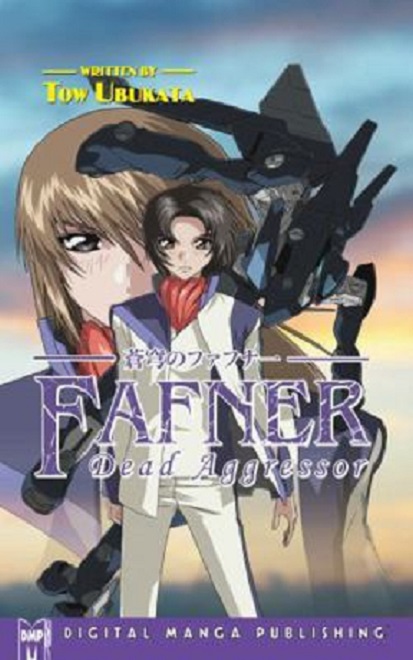Book Review: Fafner: Dead Aggressor by Tow Ubukata
Kazuki Makabe lives on Tatsumiyajima, an isolated island far off the coast of Japan. He’s looking forward to leaving the island one year from now, one way or another, whether to go to a mainland school or join a fishing boat crew. He’s the best athlete on the island, but doesn’t think too much of it–I mean, #1 of 60 boys his age isn’t that much to brag about. He has a couple of friends, but he hasn’t talked to his former best friend Soshi in nearly five years. That, and many other things, is about to change.

This “light novel” is based on the first few episodes of Fafner in the Azure: Dead Aggressor, an anime that aired in 2004. It had character designs by the people from Gundam Seed, but the sensibilities are much closer to Evangelion.
It turns out that Japan, and most of the Earth, has been invaded by hive-mind aliens called Festum, who have basically won, with only remote outposts left to resist. Tatsumiyajima turns out to be an artificial mobile island that’s been covered by a holographic “mirror” that rendered it invisible from the outside. Unfortunately, the telepathic Festum have finally narrowed down the stray thoughts they’ve been picking up and located the island.
The humans were really close to being ready to defend themselves, with their Fafner mecha, piloted by the teenagers of the island (who’ve they’ve secretly been preparing since childhood). In just one more year, the program would have gone live. As it is, Kazuki’s the closest thing they have to a ready pilot, and Soshi to mission control, and they must work together to defend the island with the Fafner Mark Elf.
The novel reworks the first few episodes of the TV series, starting with an ambiguous prologue when the main characters are children who’ve found a broken radio.
Then we plunge right into a battle where Kazuki is a hardened warrior to demonstrate the basics of mecha vs. alien combat. (The Festum are, on the surface, divinely beautiful.) Badly wounded, Kazuki passes out and dreams of a time when he thought there was “peace.” This portion covers the day just before the invasion and his first mission, then a bit of the early training.
Then it’s back to the present, where Kazuki must deal with the fallout of the many battles he’s fought, and how it’s changed his relationships with the other main characters.
Good: The Festum are convincingly alien and menacing. The Ring Cycle theming for the mecha is interesting. There’s some intriguing hints at what’s been going on in the backstory.
Less good: There’s a lot of repetition in the battle and science fiction sections of the story. It’s meant to explain the more difficult/unfamiliar concepts to a young adult audience, but felt like word count padding since I would see the same explanation repeated three times in as many pages with almost identical wording. (It’s possible that the translation might have flattened some of the intended effect.)
Most of the story is told from a tight focus on Kazuki, the stoic loner type. We do get omniscient narrator hints as to what’s going on with other characters, but little to no development of relationships beyond Kazuki and Soshi’s. The very end of the flashback has Kazuki beginning to bond with his new battle partner, only for the ending to reveal she’s long dead.
Content note: Emotional abuse, body horror, death of sympathetic characters in war. Teenagers should be able to handle it.
This book is an alternate telling of the first plotline of the anime, and as such isn’t very satisfying on its own. The first season of the anime is readily available on the internet, and has a really good opening song “Shangri-la.” Try that first, and if you like it, see if you can track down this novelization for an expansion.

